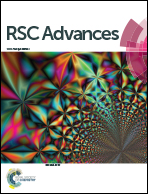Rapid formation of highly stretchable and notch-insensitive hydrogels†
Abstract
Highly stretchable and notch-insensitive hydrogels were rapidly prepared using redox initiators. The hydrogels had a large number of non-covalent crosslinking points, which come from hydrophobic side chains and metal ion coordination without any chemical crosslinking agents. The non-covalent crosslinking points in the hydrogels were stochastic and dynamic, compared to the covalent crosslinking points. When the notched sample was stretched, the hydrophobic segments would contribute to elongation of the hydrogels via molecular stretching. When the hydrogels had a notch, new crosslinking points could be formed via metal ion coordination, even if some previous metal ion–ligand bonds were destroyed. As a result, the sample notch was blunted, widened and merged into the edge gradually under tensile stress. The hydrogels could be elongated up to 12 times their original length and show notch-insensitive properties. Moreover, the metal ion coordination interaction between the amide groups and Fe3+ was proved using Fourier transform infrared spectroscopy (FTIR). The rheological properties and internal morphology of the hydrogels were also measured with different dosages of hydrophobic segments and metal ions. Thus, it was envisioned that the non-covalent bonds would make it possible to create hydrogels with more unexpected properties.


 Please wait while we load your content...
Please wait while we load your content...